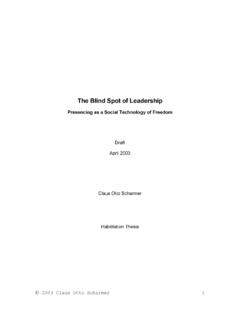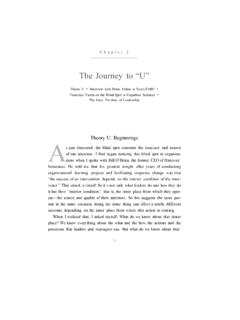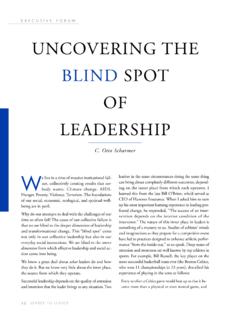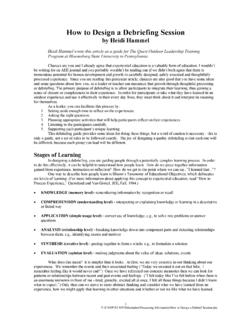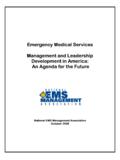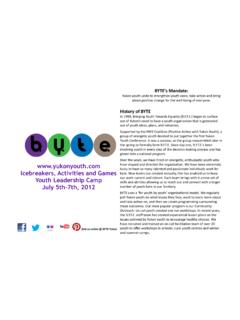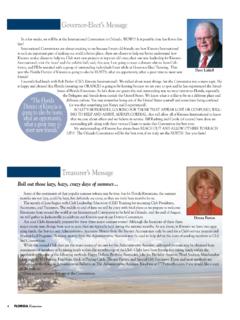Transcription of The Blind Spot of Institutional Leadership: How To …
1 The Blind Spot of Institutional leadership : How To Create Deep Innovation Through Moving from Egosystem to Ecosystem Awareness Paper prepared for: World Economic Forum Annual Meeting of the New Champions 2010 Tianjin, People's Republic of China, 13-15 September DRAFT (revised Sept. 19, 2010) Otto Scharmer Massachusetts Institute of Technology Presencing Institute 2010 Otto Scharmer 2 Tectonic Shifts We live in an era of massive Institutional and societal change. During my lifetime I have seen four major tectonic global shifts happen: the collapse of the Berlin Wall in 1989; the collapse of the Apartheid system in the early 1990s; the rise of the World Wide Web during the later 1990s; and the rise of Asia as the new center of gravity of the 21st- century global economy over the past three decades.
2 Four major tectonic shifts. Four times a massive wave of profound societal change that almost no one saw coming. And yet, four times, the seemingly impossible happened and all of a sudden the tectonic plates started shifting. Seeing and participating in these massive societal change is what defines me and my generation that is, the emerging generation of change makers and leaders within and across all institutions of society. Though the impact of these four shifts has been monumental, I personally believe that the biggest of all shifts is yet to come. It s a shift that does not deal with a technological transformation but with a social transformation: the transformation of the relationship between business, government, and civil society from manipulation and confrontation to dialogue and co-creation.
3 The purpose of this relational shift will be to facilitate profound innovation at the scale of the whole ecosystem. Torn Between Two Worlds Today, leaders and change makers across all institutions are torn between worlds: on the one hand they are confronted with a set of unprecedented 21st-century leadership challenges; and on the other they find themselves equipped with a 20th-century management toolkit that is inadequate to fix the problems they face. Between these two worlds there yawns a wide chasm that today s leaders struggle to bridge. For the past 15 years I have worked on numerous initiatives seeking profound innovation and change in business, health, and education, and on sustainability issues.
4 In all of these large systems, I have found that the biggest roadblock to moving from Institutional paralysis to profound systemic renewal is the same: it s the missing collective leadership capacity to draw together all key stakeholders and involve them in a process that begins with uncovering common intention and ends with collectively creating profound innovation on the scale of the whole system. This missing collective leadership capacity seems to be the scarcest resource in society today and yet that precious societal capacity seems to be nowhere nurtured, developed, or even focused on in our entire system of higher education. We have business schools that focus on business leadership . We have public policy schools that do the same for the government sector.
5 And we 2010 Otto Scharmer 3 have a range of departments that focus on the social sector. And yet, nowhere on campus do we have a place in which we actually focus on how these three societal sectors interact today and how they will need to interact in the future in order to address and solve the pressing challenges of our time. This gap constitutes an important Blind spot in our Institutional design and in our intellectual frames about leadership . Unless we address this Blind spot we will continue to produce results that nobody wants, such as poverty, pollution, and Institutional paralysis. The Blind Spot The Blind spot in current leaders thought is that they know all about what leaders do and how they do it but not know about the source level, that is, the inner place or the state of awareness from which leaders and social systems operate.
6 I first recognized this when I interviewed Bill O Brien, the late CEO of Hanover Insurance. Summarizing his own leadership learning as a CEO, O Brien said: The success of an intervention depends on the interior condition of the intervenor. Success, according to O Brien, does not depend on What leaders do, or How they do it. Instead, it depends on the interior condition, that is, the Source or the inner place from which leaders operate (see Figure 1). Figure 1: The Blind Spot of leadership When I first heard this idea, I realized that he had touched upon something profound in contemporary leadership research and thought. Usually we are not aware of the source dimension from which effective leadership and social action come into being.
7 It is this source that Theory U attempts to explore. 2010 Otto Scharmer 4 Theory U: The Framework Theory U is the foundation for a process built on 15 years of action research. It s a tested pathway for learning and leading change in individuals, groups, organizations, and larger systems. The basic premise of Theory U is r = f(ai). The reality (r) that a system of players enacts is a function of the awareness (a) that these players operate from. Put differently: The quality of results in a system depends on the quality of relationships between the players in a system, and the quality of relationships depends on the quality of awareness that these players are operating from. Theory U is a social field theory that differentiates among four states of awareness (or field structures of attention ) that individuals, groups, institutions, or larger systems can operate from.
8 Those four states of awareness are: I-in-me (habitual awareness); I-in-it (egosystem awareness); I-in-you (relational system awareness); and I-in-now (ecosystem awareness) (see Figure 2). Fig. 2: Matrix of Social Evolution: Four Fields of Awareness; Four System Levels (Micro - Mundo) Columns 1-4 spell out how these four states of awareness result in four evolutionary stages of social systems at all levels: from the individual (listening) to large systems (coordinating). They are: Four types of attending and listening. Listening 1 means to attend to what you already know (downloading); listening 2 means to recognize some 2010 Otto Scharmer 5 new external facts (factual); listening 3 means to see a situation through the eyes of another (empathic).
9 Finally, listening 4 means to sense the highest future potential of another person or a situation (generative). Each type of listening results in a different outcome and conversational pathway. In short: depending on the state of awareness that I operate from as a listener, the conversation will take a different course. I attend this way, therefore it emerges that way. The stages and states of conversation change from talking nice and conforming (Field 1: downloading), to talking tough and confronting (Field 2: debate), to reflective inquiry , seeing your self as part of the larger whole (Field 3: dialogue), to collective creativity and flow (Field 4: presencing). Through conversation, we as human beings create our shared reality.
10 The different field states of conversation determine the possible pathways of thinking, collaborating, and innovating in teams and organizations. The quality of collaboration depends on the interior condition from which we operate. The Institutional forms of social reality creation also evolve according to the field states of awareness outlined above. They give rise to the evolution of four different geometries of power (centralized; decentralized; networked; ecosystem) and four mechanisms for coordinating complex systems (hierarchy and regulation; markets and competition; dialogue and negotiation; awareness-based collective action) (columns 3, 4). The problem with our current approaches to leadership and systems change is that we try to solve level 4 problems with level 1-3 mechanisms.
